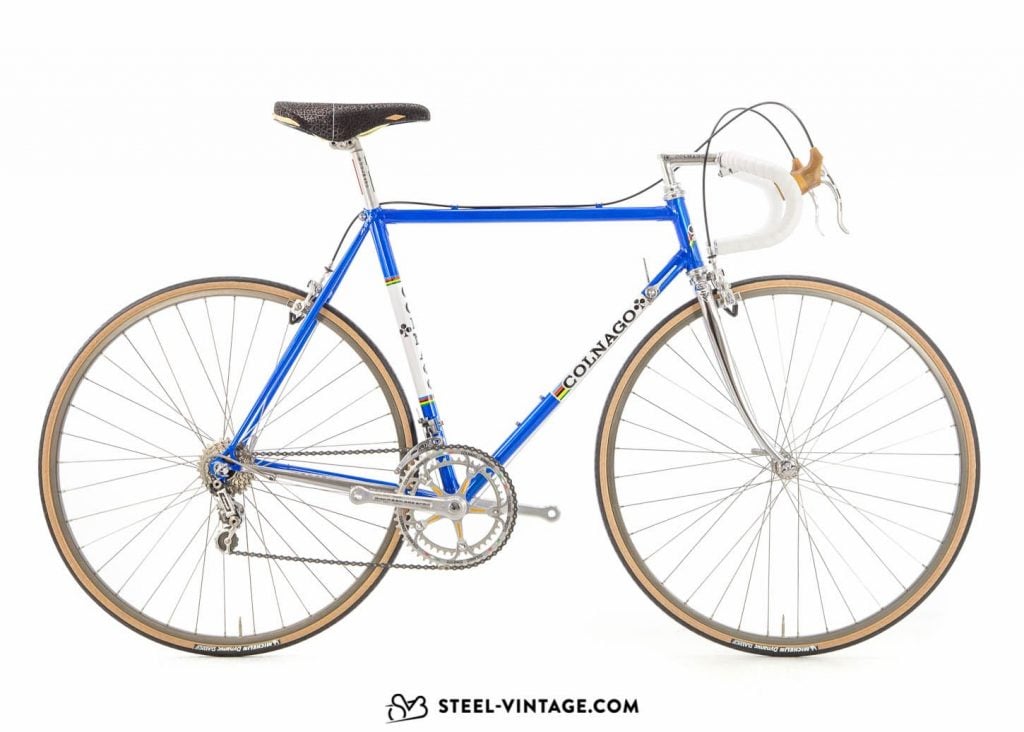
Image courtesy of steel-vintage.com
The Colnago Super Profil bicycle is the most mysterious of all the Colnago frames I have researched so far. The word PROFIL is often associated with frames that have crimped tubes. In the early 1980’s Colnago began experimenting with crimping main frame tubes to increase stiffness. Colnago referred to these crimps as ‘ribs’ in their early brochures.
I have found 3 slightly different versions of this frame.
- The first version features a crimp on either side of the top tube, crimps on the inside of the chain stays and a ‘spool’ shaped chain stay bridge.
- The second version labelled as a ‘Super’ in the 1983 Colnago catalogue (pictured below) is similar to the first version but also has 2 crimps on the down tube.
- The third version is similar to the second version, but does NOT have a chain stay bridge. A bicycle of this frame design was ridden to victory in the 1982 World Championships by Beppe Saronni. Colnago’s Hall of Fame website page refers to his race winning bicycle as a Colnago Mexico, but the actual bike in their museum is labelled a Super. Depending on who you ask this frame is either called a (early model) Nuovo Mexico or a Super Profil. Hopefully Colnago will update this conflicting information to eliminate the confusion.
In this article, I have classified all 3 versions as members of the ‘Super Profil’ family, but I cannot be 100% sure unfortunately.
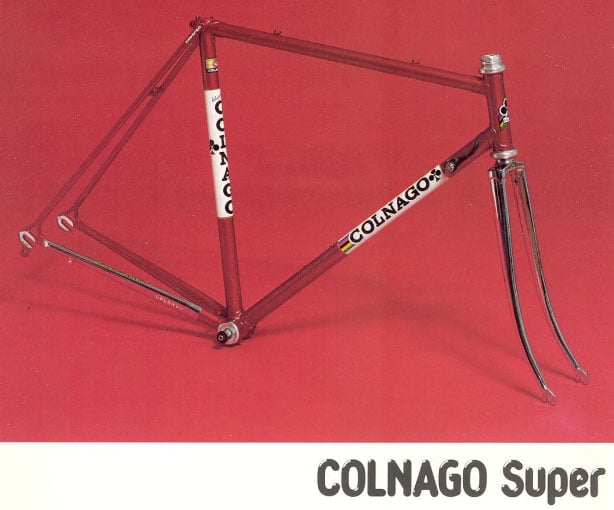
Colnago Super Profil (first version)
The first version is easy to identify by a single crimp on either side of the top tube only. The rest of the frame had the same round tubes and features as a regular early 1980’s Colnago Super including a chain stay bridge and crimps inside the chain stays.
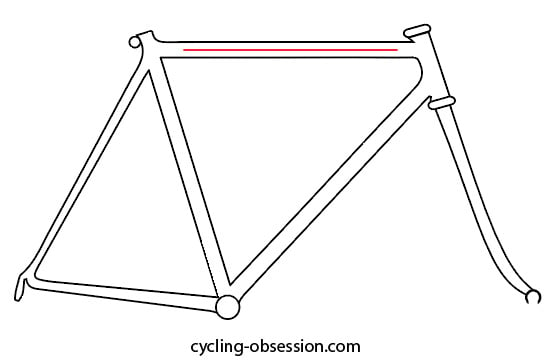
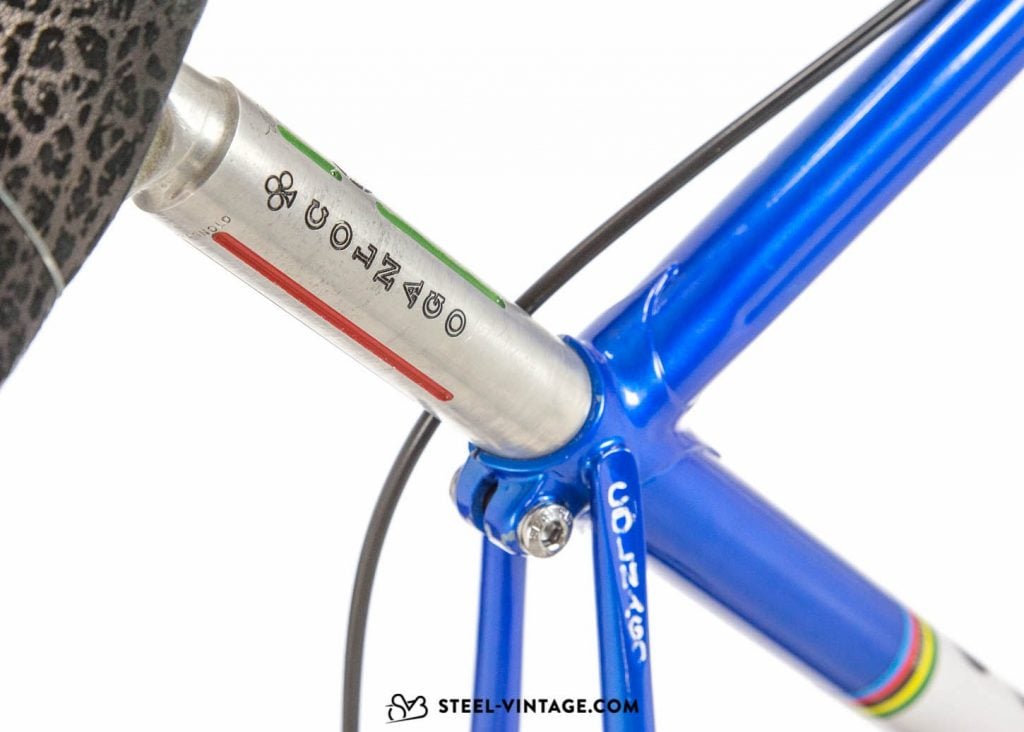
Image courtesy of steel-vintage.com
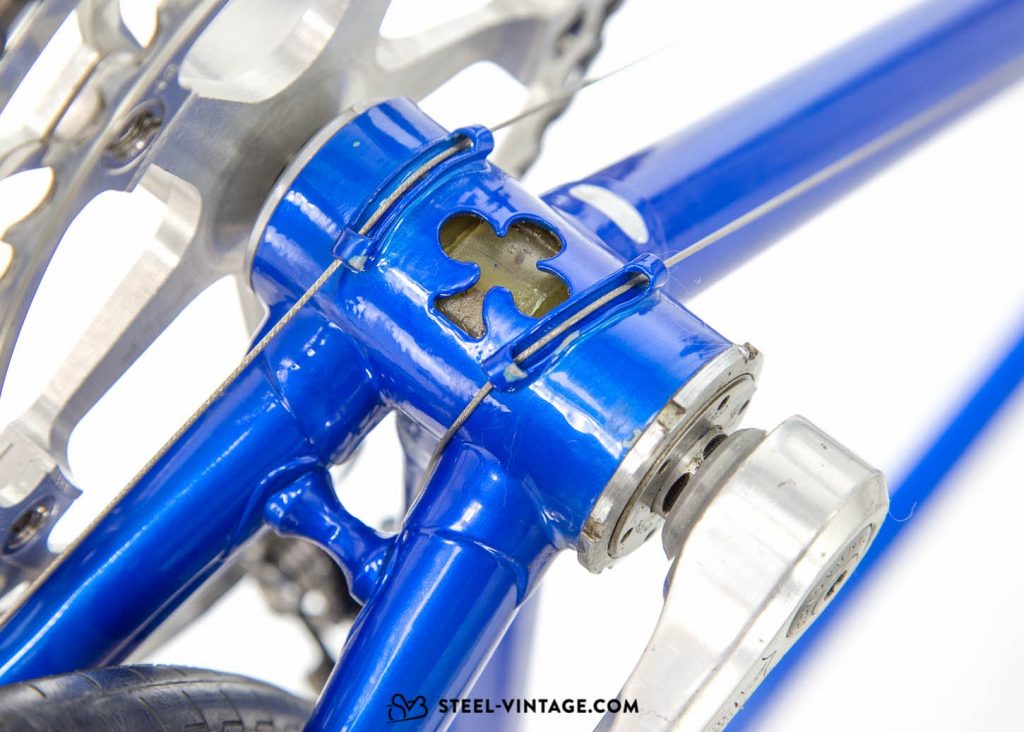
Image courtesy of steel-vintage.com
Checkout more images of a first version Super Profil bike.
Colnago Super Profil (second version)
The second version of the frame featured an added pair of crimps on the down tube and retained the chain stay bridge.
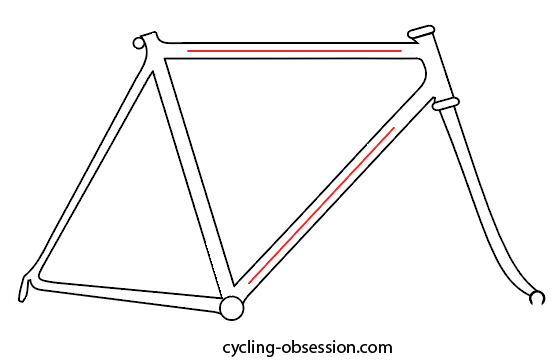
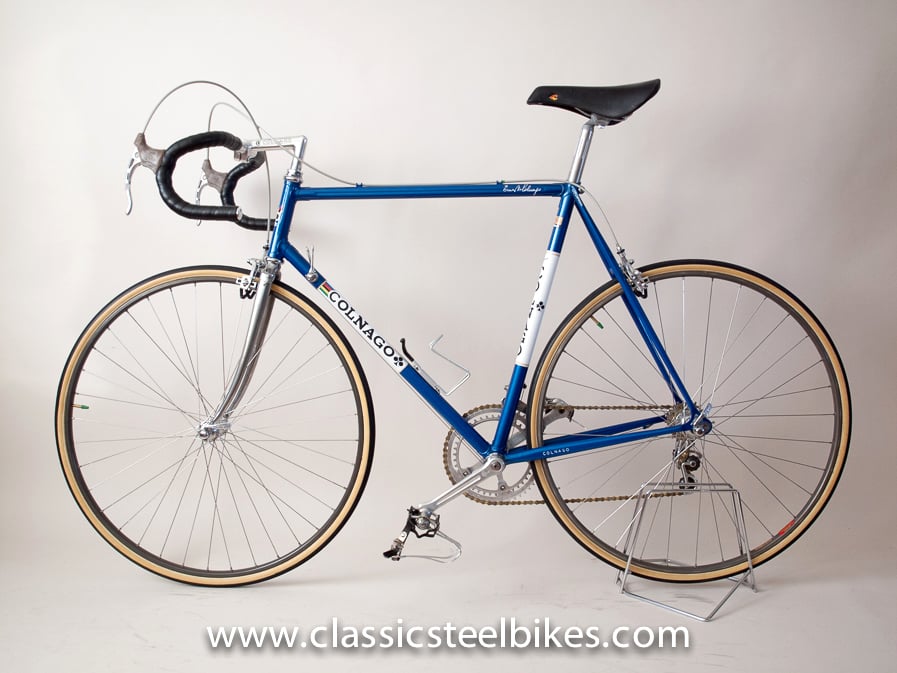
Image courtesy of www.classicsteelbikes.com
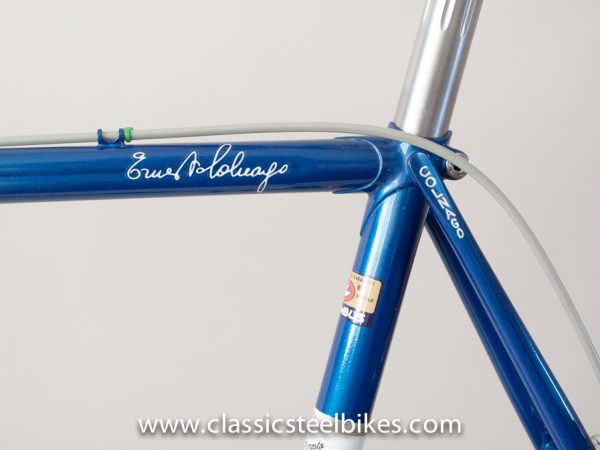
Image courtesy of www.classicsteelbikes.com
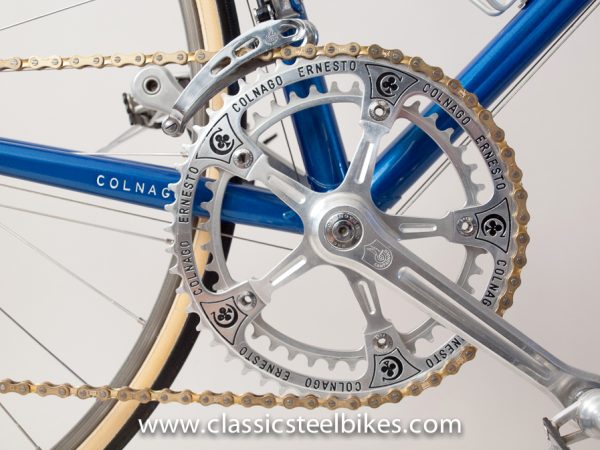
Image courtesy of www.classicsteelbikes.com
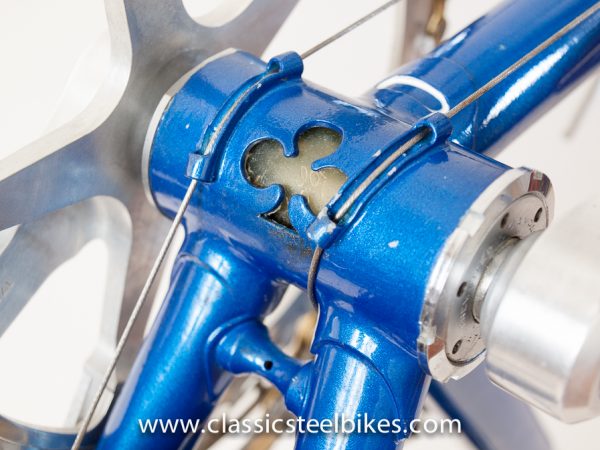
Image courtesy of www.classicsteelbikes.com
Colnago Super Profil (third version)
The third version of the Super Profil was also released in the early 1980’s. This version is easily identified by a single crimp on either side of both the top tube and the down tube and matches the bike Saronni rode to win the 1982 World Championships. It has crimps on the inside of the chain stays, but does not have a chain stay bridge (like the other 2 versions).

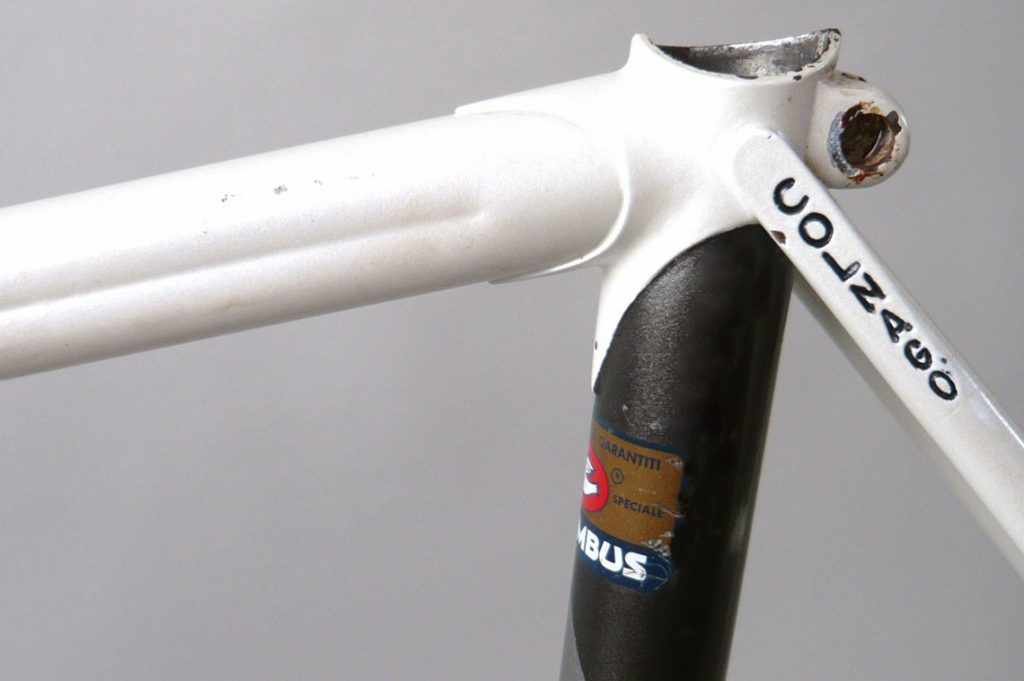
Image courtesy of www.classicsteelbikes.com
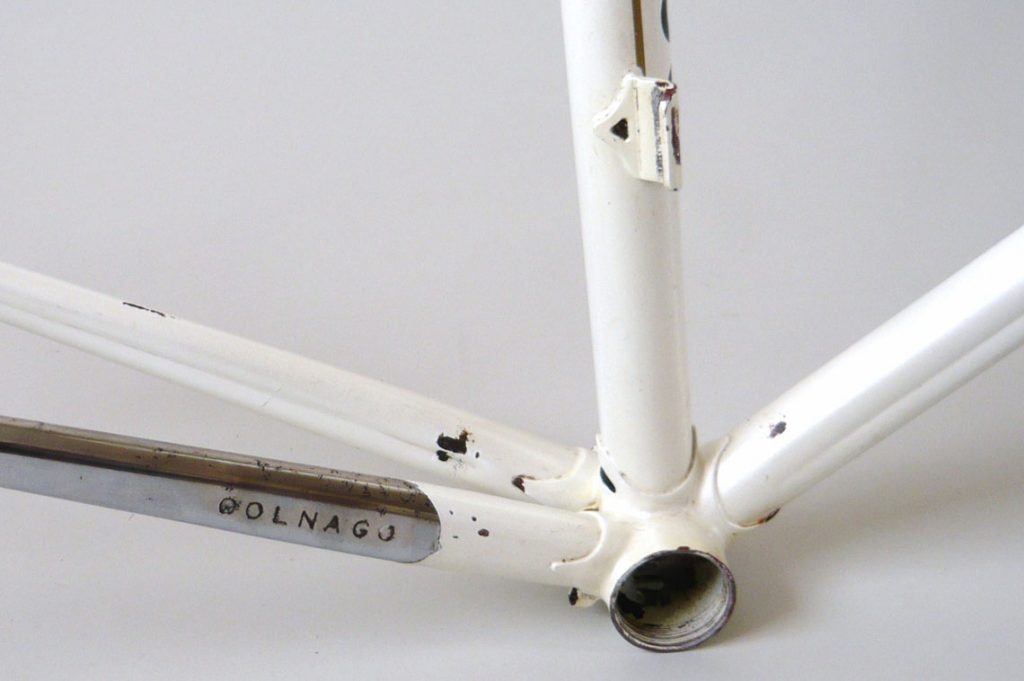
‘Colnago’ lettering on chain stay.
Brazed-on front derailleur mount.
3 Images courtesy of www.classicsteelbikes.com
It seems that the third version of these frames did not have a chain stay bridge like the other two.
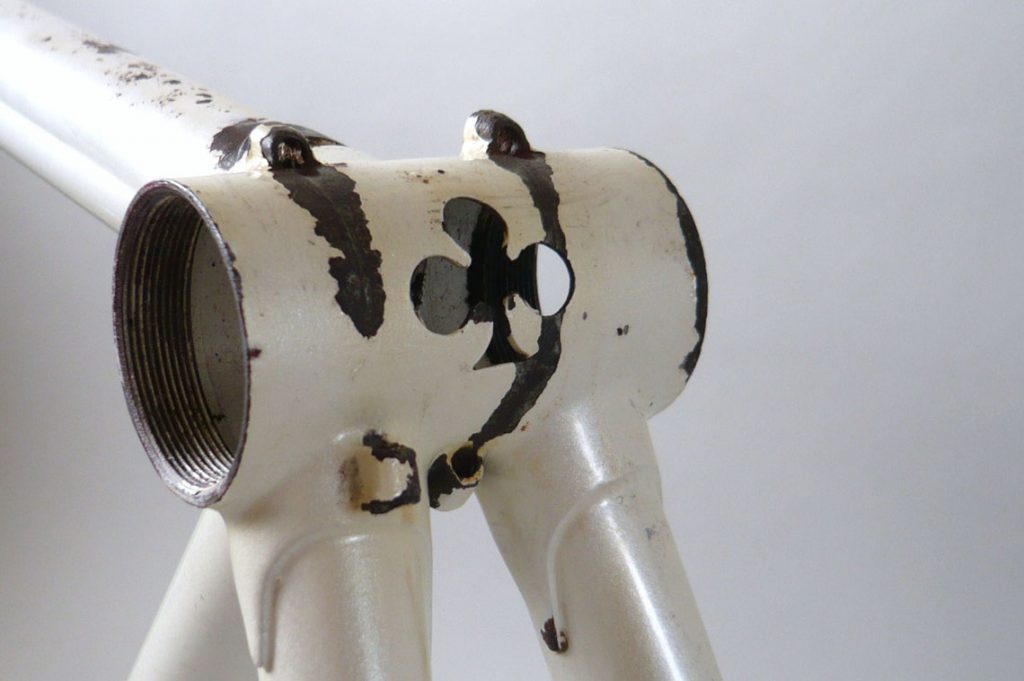
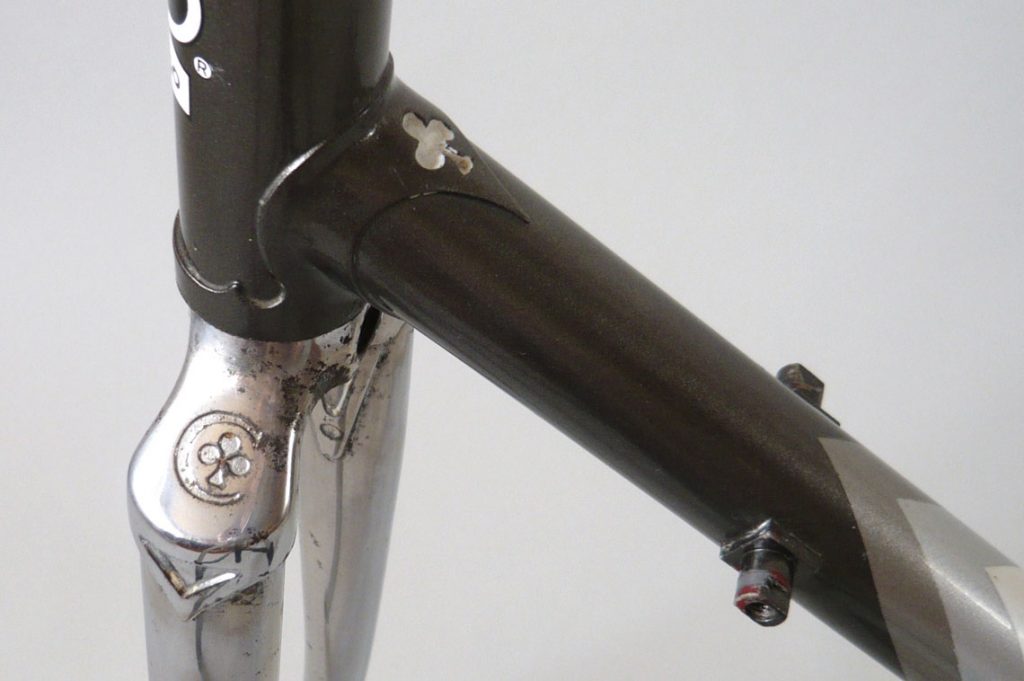
Assuming all these frames are part of the Colnago Super family, this chart provides specifications for the Columbus SL tubes that were presumably used in their construction.
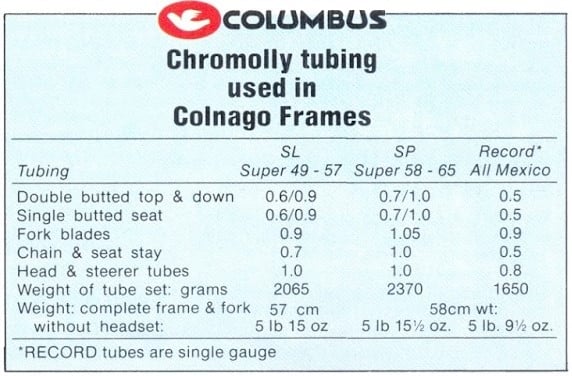
My Theory of Colnago’s Frame Evolution
Up until the early 1980’s the Colnago Super was the bike of choice by professional and amateur racers alike. However, it seemed not all riders were happy with the frame stiffness. So the idea of adding crimps to round frame tubes was conceived. This process had already been proven to add extra stiffness to chain stays, so why not main tubes as well? I believe it made sense to test this concept on their premium race bike at that time, ‘The Super’ and as such I suspect these variations of the Super Profil appeared.
Not long after inception, the third version of this frame was ridden to victory in the 1982 World Championships. The following year, a new frame design appeared in the Colnago catalogues and it is unquestionably the ‘Nuovo Mexico‘. It featured a total of 4 crimps in the down tube. As the Nuovo Mexico became the new premium race bike, the Super reverted back to manufacture with plain round main tubes.
Colnago Literature.
The following websites have a large selection scanned Colnago literature including reviews, catalogues and brochures.
Article References.
I hope you found this article interesting. I have listed the following website pages as general references.
steel-vintage.com
www.classicsteelbikes.com
Disclaimer!
Please remember that this information is only to be used as a guide.
I consider myself an enthusiast, not an expert. The information I have presented in this article is based on my many hours of online research.
In addition, there will always be frames that don’t quite match the characteristics of a particular model as they could have been a custom build, prototype etc. Note: forks can also be swapped between different frames.
About Me.
I have been riding and working on my own bikes for many years now. I wanted to share my experiences, knowledge and research with others. My aim is to inspire people to get involved in all aspects of this amazing sport. Cheers.
Comments.
I welcome reader feedback in the comments section. Should you wish to suggest an amendment, please include a note advising the source of your information so that myself and other readers can ascertain the accuracy of your information. Note: Trolling or argumentative comments will be removed as they are counter-productive.
I have been dealing in vintage Colnago bikes a number of years .
There is no model with just two ribs in the model as you are stating , and the SP/SL chart relates to Mexico and Supers from the 1970’s .
Hi Saarf,
Thanks for your interest in this article. Whilst I was unable to find mention of a Super Profil in any Colnago catalogue I have on file, I have found pictures of a blue Colnago that has 2 crimps; one on each side of the top tube, and NO crimps on the down tube. Whilst this bike has a decal saying ‘Colnago Mexico’ on the chain stays, research suggests the original Mexico did not have crimped chain stays and the Nuovo Mexico’s do not have a chain stay bridge, so I suspect the Mexico decal is not original. All these features are commonly found on a Super, so I have categorised this frame as a Super Profil as it is different to the standard Super.
As for the Columbus tubing chart, I found it in an old American catalogue from 1981, so it is quite probably older than that, but I just dated it according to the source of the data. However, the content is still relevant as Super frames were still being made with Columbus SL tubing well into the late 1980’s.
Hi Saarf. Do you recognise any of Colnago model with hangers for air pump under main tube?
I just bought a bike which has Colnago stickers but honestly don’t know what it really is 🙂
I can send pics on e-mail if you’d like to see them.
Thanks!
Hi Bartek, Saarf has his own blog website which is not related to this cycling website. You may want to post your question on his blog. However, I am yet to see a Colnago frame advertised in their older catalogues with pump hangers fitted to the tubes. Other than the decals you should be looking for some stampings that match one of the many Colnago frames illustrated in this website.
Hello,
I have a super original Colnago with NR all round stamped pat. 76… and the top and down tube are crimped…
I am almost certain this is earlier than 1980 and hs not been rebuilt. Do you think they could have been crimping earlier?
Thanks
See picture:
crimped Super
Hi Alex, really nice bike with a super small frame. Certainly looks very original, but looking at the frame features, it has recessed brake fixing nuts and Colnago stamped on the chain stays. To me, those features are more 1980’s Colnago frame design rather than 1970’s. It’s quite possible the bike was originally built up with older NR parts (dated from the 1970’s) or some parts were swapped out in the past 35 years..I hope you are going to ride it, although you may want to replace the tyres..Also aftermarket rubber brake hoods are easy to get on eBay. You should still keep the original ones.
I have a Colnago Super Profil Version 3 / Nuovo Mexico Version 1 bicycle with the following frame characteristics:
Columbus SP (likely) tubing, seat tube 60cm C-C, top tube 58cm C-C, head tube 13cm C-C. The ST has a white and blue Columbus tubing sticker with a white dove on red background. Single crimp on each side of both the top tube and down tube; crimp on inside of each chain stay with COLNAGO on outer edge of each; no chain stay bridge; Club cutout and cable guides on bottom of BB without Colnago name; no Club logos on top of BB, sloping fork crown with hidden brake bolt and COLNAGO and Club logo on each side but the Club logos do not have a surrounding C; chrome curved blade fork with COLNAGO dropouts; chromed rear triangle with 130mm (originally 126mm) spacing and CAMPAGNOLO dropouts; seat stay bridge with hidden brake bolt and Club logo; head tube lugs are chrome with Club logo on lower lug; COLNAGO flat caps on seat stays; paint is original with top tube and down tube painted blue beginning at head tube and then fading to silver midway along the top and down tubes with a large blue grid pattern highlight on the top of both tubes: the blue grid pattern is also on the rear of the silver seat tube with “MAST” vertically in stylistic large black outlined yellow letters on the rear of the tube below the typical Colnago Club sticker. There is no contrasting paint fill on any of the Club logos. Braze-on fittings for TT cable guides (2), DT bottle cage, ST derailleur, below BB cable guides, DT shift levers, chain stay cable stop.
The bicycle is built with an eclectic mix of components. Campagnolo C-Record Corsa: Crankset 53/39T, Derailleurs, 36h Hubs, aero Seatpost and Delta Gen 2 Brakes. The hubs are laced 4x with DT Swiss spokes to FiR EA60 Rims. Campagnolo Record Titanium Ergopower 8-Speed Levers. Cinelli XA Stem 120mm. Modolo 6X-TENOS Bar 44cm C-C. Cinelli Cork Tape. Sele SMP Stratos Saddle. Miche Primato 8-Speed Cassette 12-23T. Colnago branded Look PP286 pedals. Hatta Hattaswan headset. Campagnolo Centaur three bearing 111mm BB.
I have several older road bikes circa 1972 to 2005 made in France, Italy, Belgium and Mexico but this Colnago Super Profil V3 / Nuovo Mexico V1 is my favorite bike to ride.
Hi Lawrence, interesting to hear the Colnago is your favourite. Did you buy this bike NEW?
Purchased used in Netherlands. See pictures. https://www.amazon.com/photos/shared/dv-01e90S8eGN0aec5I1ZA.3cnnp–8AHEVUq0BZ-na4n
This website is a pleasure and helped identifying my Saronni-Red Colnago as a super profil 3rd Version / 1st Nuovo Mexico model.
It is really special though, because it has the number E001 on its dropout. A real „prototype“ that was owned and set up by Karl Lauer, who had it in his private collection when he was still alive.
Never ridden and a stunning build up with all pantographed parts and razor-/knifespokes on 28 wholes SSC-Rims. Lauer was knwon and unique for building wheels with those spokes as he had to prepare the hubs to get them through the holes.
The longer I own the bike the more I get the feeling its a peace of history that should go to the museum. Ernesto Colnago hasn‘t given away much often a serial-number 1 frame. Makes scenes that only a guy like Lauer – as a friend and a prominent TdF-Mechanic – got the chance 🙂
So lucky to be the owner today.
Would appreciate to get in Contact with the creator of this Website to send photos and discuss more information!
Just contact me via Email.
Cheers 🙂
Hi Miro, thanks for your kind words about the website. I’m glad you were able to learn more about your Colnago bike. Very interesting and amazing history and you say never ridden?? Surely you must be tempted?? I think everyone would be interested to see images of the bike, particularly the wheels and hubs with those unique spokes fitted.
You can post a link to images in the comments section of this page using these instructions: How to share images on Cycling Obsession.
Hi, I congratulate you for the research work carried out and for the clarity of the information. I recently viewed a Colnago bike but I cannot identify the model. I assume it has undergone some restorations over the years. As you will see the bike has a single crimp on both sides of both the top tube and down tube. I kindly ask you if you can help me in this research, viewing the photos that I am attaching.
Thank you for your kindness and my greetings.
Photos of the bike
Marco
Hi Marco, it is a bit hard to see the crimps in the photo’s, but if it is as described in your comments, some people call it a Super Profil, some call it a 1st version Nuovo Mexico. However, this bike has some Campagnolo 50th anniversary components which are very special. Enjoy.
I received confirmation today from Colnago that this is Super Profil, as indicated by you. It is the commercial version without the colors and decals of the “Del Tengo” team from Saronni. Thank you very much and congratulations again for the work done.
Hi Marco, thanks for posting the confirmation you received from Colnago, I’m sure this will be of interest to other people as well. All the best.
I purchased a Super Profil from Steel Vintage bikes which has internal cable routing on the top tube. All of the photos I have seen show external cables. It has crimped top tube. Is this definitely a Super Profil?
Thanks
Hi Stephen, SVB are pretty knowledgeable when it comes to identifying vintage bikes. Generally I believe the key point of distinction for the Super Profil was the single crimp in the top and / or down tube(s) as mentioned in the article. I believe internal routing of the rear brake cable was offered as an option for Colnago frames that were made to order, so it is not usually a defining characteristic when identifying a Colnago frame. I believe this routing started around the early 1980’s and continues into modern day Colnago steel frames.
I just purchased a 52cm C-C Colnago frame and fork on Ebay advertised as Mexico but a lot of people on the bike forums says it is more likely a Super and not a Mexico. I havent received the frame yet. Here are the different features of the bike:
1. Cables guides under the bottom bracket, all tubes are round.
2 “Club” shape hole cut out under the bottom bracket.
3. Seat stay marked “Colnago” close to the top tube.
4. Fork is chromed square top and marked with the “club” and the world “Colnago” underneath it.
5. The chainstay bridge is an “hourglass” shape.
6. There is a “Colnago” name at the chainstay and is chromed.
7. There is NO crimped in the chain stays tubings inside or outside.
8. Frame weight is 1860 and fork is 710 according to the seller ( I still have to ferify these weights when I get them )
Everything points to it being a Super. The only feature that it may not be is because there is no crimp on the chain stay tubes. What do you buys think?
Hi Gerry, I suspect it may be a 1980’s Super having an hourglass shaped chain stay bridge and no crimps on the chain stays. Based on my research of the Mexico, it had a cylindrical chain stay bridge as you can see in the photos on How to Identify a Colnago Mexico.
I bought a Colnago Super from eBay and I am pretty sure it is a 78 based on this guide. Thank you for that! The one thing that concerns me is that the top of the seat stay doesn’t say Colnago at the top. It has the club cutout on the bottom bracket. The front caliper bolt is recessed into the frame. The top of the fork has Colnago and the club. It does not have any chrome other than the top of the fork. My only questions are the top of the seat stay and the color is cream white with black logos outlined in yellow with very little chrome.
Hi Brian,
It can be tricky as Colnago frames do have so many small variations in production over years so it is hard to advise exact year and model type assuming plain round tubes.
Recessed front brake caliper bolt would be a clue to age of frame if the fork is original to the frame, is the back recessed also?
Then you can check what era group sets moved to recessed brake caliper bolts as this wasnt always the standard.